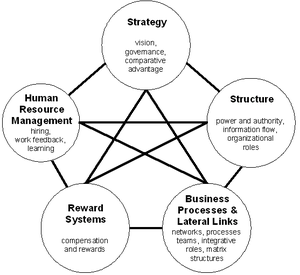Jay R. Galbraith
Appearance
Jay R. Galbraith (Feb. 26, 1939 - April 8, 2014) was an American organizational theorist, consultant and Professor at the International Institute for Management Development, known for his work on strategy and organization design.
Quotes
[edit]
- Organization design is conceived to be a decision process to bring about a coherence between the goals or purposes for which the organization exists, the patterns of division of labor and interunit coordination and the people who will do the work.
- Jay R. Galbraith (1977). Organization design. p. 5
- If management can identify the negatives of its preferred option, the other policies around the star model can be designed to counter the negatives while achieving the positives.
- Jay R. Galbraith (2002), Designing organizations: an executive guide to strategy, structure, and process. p. 15
Designing complex organizations, 1973
[edit]Galbraith, Jay R. Designing complex organizations. Addison-Wesley Longman Publishing Co., Inc., 1973.
- There is no one best way to organize... Any way of organizing is not equally effective.
- p. 2: The two underlying assumptions of contingency theory
- The greater the task uncertainty, the greater the amount of information that must be processed among decision makers during task execution in order to achieve a given level of performance.
- p. 4
- [Task uncertainty is] the difference between the amount of information required to perform the task and the amount of information already possessed by the organisation.
- p. 5
- Organizations make two responses to deal with the behavior control problem. The first change involves the substitution of craft or professional training of the work force for the detailed centralized programming of the work processes.
- p. 12
- If the organization is faced with greater uncertainty due to technological change, higher performance standards due to increased competition, or diversifies its product line to reduce dependence, the amount of information processing is increased. The organization must adopt at least one of the four strategies when faced with greater uncertainty.
- p. 26
Organization design: An information processing view, 1977
[edit]Galbraith, Jay R. "Organization design: An information processing view." Organizational Effectiveness Center and School 21 (1977).
- The empirical research of the last fifteen years on the structure of large organizations seems to confirm the hypothesis of Herbert Simon that human cognitive limits are a basic limiting factor in determining organization structures .
- p. 21
- The basic proposition is that the greater the uncertainty of the task, the greater the amount of information that has to be processed between decision-makers during the execution of the task. If the task is well understood prior to performing it much of the activity can be preplanned. If it is n~t understood, then during the actual task execution more knowledge is acquired which leads to changes in resource allocations, schedules, and priorities.
- p. 21

